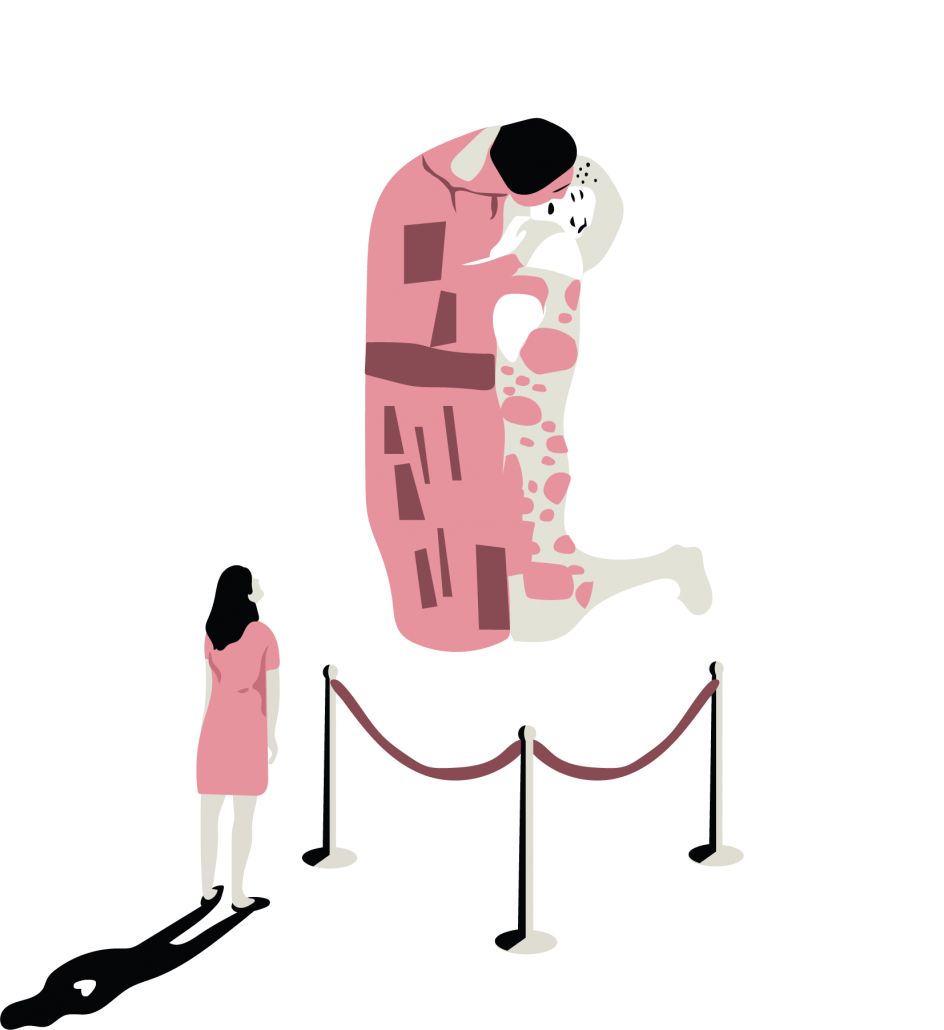State of the Art: Life imitates art when it comes to love

Growing up, there was one work of art that defined my childhood memories, and I can visualize it most clearly in my mind’s eye. I didn’t know it then, but Gustav Klimt’s “The Kiss” was so much more than a framed print of two people kissing that decorated the wall in my parents’ bedroom. I remember first seeing it as a patterned, yellow blob — the man and woman, abstractly composed, are so closely intertwined that their robed bodies are practically merged as one. Some years later, I finally came to recognize them as blissful lovers, shrouded in gold. Naturally, I saw them as projections of my parents, who were the premier model of romance in my life at the time.
In the painting, Klimt enhances the lovers’ physical and emotional intimacy through the closeness of their bodies and the realism in their expressions. Even as a little girl with negligible art history knowledge, I recognized the euphoria and obsession in their postures and faces — these were two people who reveled in each other’s presence. Naturally, I wanted what they had for myself someday.
At the risk of sounding precocious beyond my 20 years, I’ve done quite a bit more living and learning than that little girl I used to be. Shit happens. Boys break your heart. Parents split up. Call it poor taste in partners or a symptom of having parents currently in the midst of a contentious divorce, but over the years, I have inadvertently become a staunch cynic when it comes to love. Suddenly, all signs seemed to point to the futility of love and the deceit behind Klimt’s portrayal. I can’t help but wonder if Klimt’s lovers knew their only options were to break up or die together.
Unfortunately, visions and iconography of love are inescapable — especially as the capitalistic gears of Valentine’s Day churn this week. In art history especially, portrayals of love smolder in every period and genre. Whether through tender gazes, flirtatious poses or ravenous embraces, art has long rendered acts of desire and romance to capture the all-encompassing, mind-altering effects of the drug we call love.
Lucky for us skeptics, not all these iterations of love are as idealized as Klimt’s. Rene Magritte’s “The Lovers” alternatively visualizes the complexities of love, particularly the interactions between the mind and heart. Its subjects are a man and a woman with their lips interlocked, their heads cloaked by fabric, so their identities are erased. Despite the passion evident in their body language, the depersonalized nature of the work draws upon darker themes of frustrated desire, obstructed intimacy and unsolicited obsession. The lovers are suffocating one another, yet their lust transcends their suffering. To me, Magritte is illustrating a side of love that is no less real than the romantic stuff, even if it’s not as pretty.
Not only is real love less pretty, it can be downright dirty, according to photographer Nan Goldin’s “The Ballad of Sexual Dependency.” Goldin’s exhibition-turned-visual diary chronicles her friends, family and lovers’ struggles to find intimacy in Reagan-era New York City during the counterculture movement. The photographs document scenes of love and sex as experienced in Goldin’s underground world — a scantily-clad young couple hungrily making out with drug paraphernalia littered around them, a woman’s face bruised at the hands of her domestic abuser, a wrenching portrait of a couple collapsed in each other’s arms on a decrepit couch. The images are a meditations on the nuanced forms love and romance can take. Visceral and raw, they strip away all illusion and expose the primal human desire for affection and connection.
At the end of the day, no depiction of love in art emerges as the truest. I have been kissed by someone who held me with the gentle infatuation Klimt’s subjects exhibit. I have ached for someone so badly that I’d sooner be suffocated like Magritte’s characters than be without them. I have performed my own ballads of sexual dependence in an attempt to make meaning of the gray areas. As it turns out, every depiction has its merits because it teaches us something new about how to love.
My days of blindly heralding Klimt’s painting as the golden standard of love may be long over, but art reminds me that loving and being loved are what make life worthwhile. In all its forms, love is worth pursuing, having and losing. And despite my cynicism, I’m excited to experience all the soaring highs and harrowing lows my next love might bring.
Now long forgotten by both my parents, “The Kiss” still hangs in our empty basement guest room, a relic of the flawless love I once believed in. But maybe someday, when I find the perfect person with whom to share a flawed but no less legitimate love, I’ll ask if I can have it for our bedroom wall.
Catherine Yang is a senior writing about art and visual culture. She is also the digital managing editor of the Daily Trojan. Her column, “State of the Art,” runs every other Wednesday.

